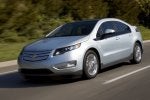
[ad#post_ad]When the Chevrolet Volt concept was first unveiled in January 2007 it illustrated the use of a 1-L 3-cylinder combustion engine. Other variants of the Voltec propulsion system, then known as E-Flex, were also demonstrated at various times. These included hydrogen fuel cell and diesel concepts.
In the end GM decided to go with a 1.4 L normally aspirated 4 cylinder engine that will also be used in other GM cars including the high volume Chevy Cruze expected to launch in the fall.
GM has apparently been continuing to study other possible range extenders, according to a report from Edmund's, with the hope that one of these could make its way into the second generation of the car expected in the 2013-2014 timeframe.
One of the barriers to the Volt making it to high sales volumes is the considerable expense not only of the battery but of the complex extended range drivetrain, something pure EVs like the LEAF do not have to contend with.
"Right now, the propulsion system is too expensive, even with using an existing engine," said GM's new vice president of global vehicle engineering, Karl Stracke.
Stracke explained that GM is looking carefully at several different range extenders for future generations. These systems include two cylinder gas engines, diesel engines, and even rotary or Wankel engines.
"We have a strategy to go rotary engines or a two-cylinder [gas] engine making 15-18 kW," said Stracke. "Rotary has a higher fuel consumption but here's the advantage [holds up his hands to form round, frisbee-sized shape] — packaging."
Stracke has even piloted a rotary engine-powered Volt prototype. "I have driven the car already," he said.
"One rotor could be enough," he added. "Of course with the higher rpm of a rotary, you need to have an NVH solution."
Stracke also believes a diesel powerplant could find its way into the Volt. "The cost of the engine would be higher for the manufacturer," said Stracke of the diesel engine, "but the fuel costs would be cheaper for customers."
To reach high volume sales, not only does GM have to lower the cost of the powertrain but also the cost of the battery pack. And, for the first time in the history of GM-Volt.com a GM executive finally admitted the total cost of the Volt's 16 kwh lithium-ion pack.
The pack costs "roughly $10,000," said Stracke. He also said that GM is "working aggressively to get that cost down 50 percent" for the next generation Volt.
"The future of the automobile has never been as interesting as it is right now," said Stracke. "Big question is, what new propulsion system will come next?"
Source ( Edmunds )
[ad#postbottom]





